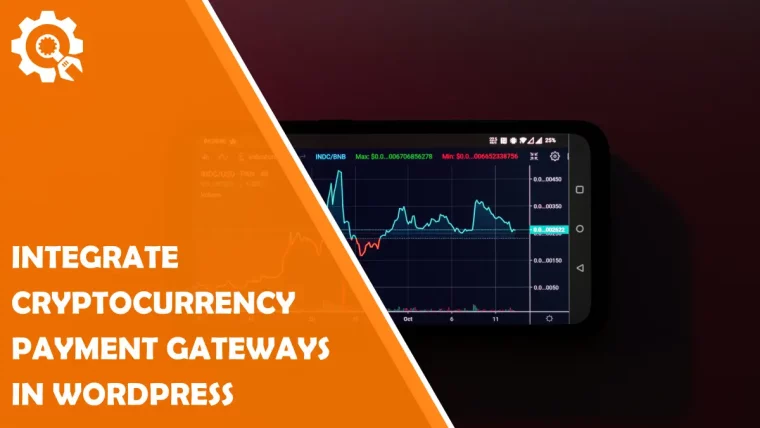Since its creation in 2003, WordPress has expanded its service offering from blog publishing software to mailing list creation, online stores, media galleries and website building. Its growth into e-commerce platforms has helped millions of users to advertise and sell their products successfully.
Cryptocurrencies are being integrated onto websites and into digital shopping portals, to attract a younger, more tech-savvy market. Lower transactional fees, quicker payments and heightened online privacy are fuelling the adoption.
Payment gateways also known as crypto processors allow WordPress users to accept cryptocurrencies. They also keep track of transactions and useful conversion charts (such as the Ethereum chart or Bitcoin chart), and many allow users to exchange their crypto holdings into fiat currencies.
This article delves deeper into crypto payment gateways and how to set one up for your online business.
Understanding Cryptocurrency Payment Gateways
At its core, a cryptocurrency payment gateway or processor is third party software that helps users accept cryptocurrency tokens. Payment gateways are set up to accept a number of crypto tokens, including Bitcoin, Ethereum, Binance Coin, Dogecoin, Litecoin, USD Coin and many more.
Gateways allow businesses to transact using cryptocurrencies, by converting them into fiat currency or enabling merchants to hold crypto directly.
Follow These Steps To Set Up Your Own Crypto Processor
Step 1: Choose the Right Cryptocurrency Payment Gateway
The first step to integration is selecting a payment gateway that suits you and your business needs, some of the most popular include:
1. Binance Pay, finds itself in the top spot. The payment gateway allows users to accept several cryptocurrencies, it also offers users access to crypto exchanges, crypto storage and helpful conversion charts.
2. BitPay, focuses on Bitcoin and Bitcoin Cash. The plugin is well-established and widely trusted.
3. CoinPayments, this versatile platform accepts over 1,000 cryptocurrencies, helping merchants to reach a wider audience.
4. CoinGate, supports various cryptocurrencies and offers easy integration with WordPress which helps first time gateway users.
5. CryptoWoo, is a dedicated WooCommerce plugin that allows for Bitcoin payments directly. Making it ideal for businesses looking to specialize in Bitcoin adoption.
Merchants should factor in transaction fees, supported cryptocurrencies and customer support when choosing a payment gateway partner.
Step 2: Set Up Your WordPress Site
If you haven’t done so already, the next step is setting up your WordPress e-commerce site:
1. Install WordPress, make sure to select a reliable hosting provider that supports WordPress installations. Pro Tip: Under Construction pages help businesses look more professional while their WordPress site is being built. Consider using one and including your contact details.
2. Choose an E-commerce Plugin: A common choice is Binance Pay, which adds powerful e-commerce capabilities to your WordPress site.
3. Configure Your Store: Set up your store settings, including products, pricing, shipping and tax settings.
Step 3: Installing a Cryptocurrency Payment Gateway Plugin
After selecting your payment gateway, you’ll need to install its corresponding WordPress plugin. Here’s how to do that for some popular gateways:
For Binance Pay:
1. Navigate to Plugins: In your WordPress dashboard, go to Plugins > Add New.
2. Search for Your Gateway Plugin: For example, search for “Binance Pay.”
3. Install and Activate: Click on the Install Now button and then activate the plugin.
Configuration:
After activating the plugin, you’ll need to configure it:
1. Go to Binance Pay Settings: Navigate to Binance Pay > Settings.
2. Select the Payment Tab: Here, you will find the installed payment gateways.
3. Enable the Gateway: Check the box to enable your chosen cryptocurrency gateway.
4. Configure Settings: Enter any required information, such as API keys or wallet addresses. Most gateways provide detailed instructions for this process.
Step 4: Customizing Payment Options
Merchants can target a wider audience by accepting a variety of cryptocurrencies, payment gateways typically allow users to select their cryptocurrencies of choice:
1. Enable Multiple Cryptocurrencies: If your gateway supports it, enable multiple cryptocurrencies to cater to a broader audience.
2. Set Payment Instructions: Provide clear instructions for customers on how to complete the payment using cryptocurrencies.
Step 5: Testing Your Integration
It is recommended to test your payment gateway before accepting payments, this helps to iron out any kinks and ensure smooth service to your customer base. Here’s how to do that:
1. Enable Sandbox Mode: Many gateways offer a sandbox mode for testing. Enable this in your gateway settings.
2. Place Test Orders: Go through the checkout process as a customer would, selecting cryptocurrency as the payment option.
3. Verify Transactions: Check both the customer experience and the backend transaction records to ensure everything is recorded correctly.
Step 6: Launch and Monitor
Once testing is complete and you’re confident in your setup, you can officially launch the crypto payment option:
1. Announce the New Payment Option: Use your website, email newsletter and social media channels to inform customers about the new cryptocurrency payment option.
2. Monitor Transactions: Keep an eye on the transactions and customer feedback. This will help you identify any potential issues early on.
Step 7: Staying Compliant
As you start accepting cryptocurrency, it’s important to stay compliant with local regulations regarding cryptocurrency transactions. This can include:
1. Tax Implications: Understand how cryptocurrency transactions will affect your tax obligations.
2. Consumer Protection: Ensure your refund and return policies are clear for cryptocurrency transactions.
Benefits of Accepting Cryptocurrency Payments
Integrating cryptocurrency payment gateways in your WordPress site comes with several advantages:
1. Lower Transaction Fees: Compared to traditional payment methods, cryptocurrency transactions often have lower fees.
2. A broader market: Crypto Payment gateways make a business more appealing to tech-savvy customers. Many merchants have realized the marketing appeal of accepting crypto tokens.
3. Enhanced Security: Cryptocurrency transactions are secure and reduce the risk of chargebacks, which can be a significant issue for online merchants.
In Summary
The ease of implementation has many WordPress based merchants adopting crypto payment gateways. Merchants who do so benefit from lower costs, faster transaction times, heightened privacy and broader appeal – helping to set them apart.
